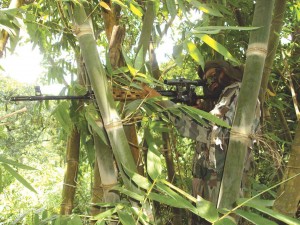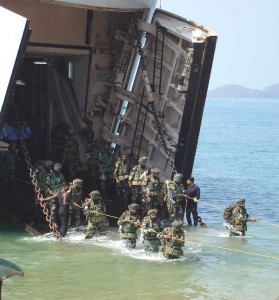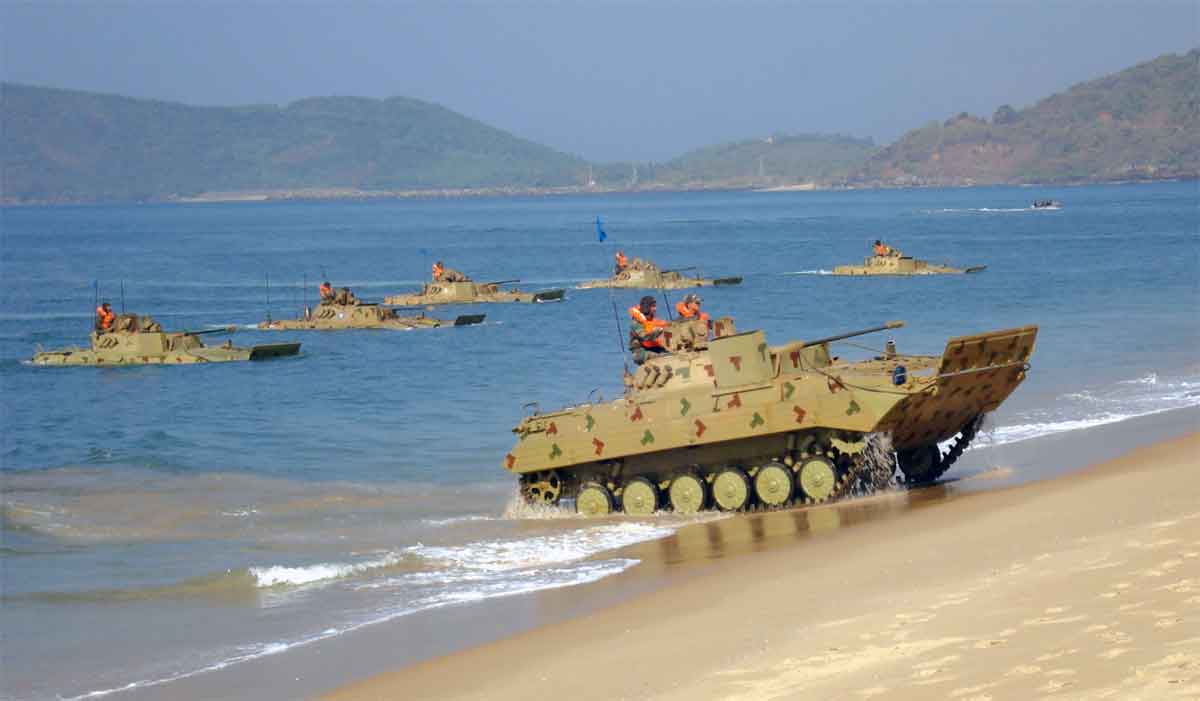No matter how hi-tech the modern battlefield gets. No matter how powerful the Drones and the Robots become. The mission of the Infantry will continue to close-in and destroy the enemy, through close quarters violent combat in any war operation. This old Infantry saying will never be outdated, “When it was victory, the Cavalier claimed it outright, the Gunner boasted of his calibre but the Infantryman stood silent with victory at his feet.”
Effective and precision firepower with integrated 24×7 all-weather surveillance holds the key to success in any challenge on the LoC.
I had an implausible career spanning of over twenty years as a hard core Infantry soldier. I commanded 9 SIKH LI, the same battalion that I was commissioned into. Like most of the Infantrymen, I hold a distinction of serving in almost all types of terrain that India has to offer. My operational career include tenures at the world’s highest battlefield, the Siachen Glacier, Eastern Ladakh opposite the Chinese on the Line of Actual control (LAC), two active Line-of-Control (LoC) tenures against the Pakistanis; one at Tangdar in Kupwara district and another at Mendhar in Poonch district. My soldiering skills were honed in the years 1998 to 2000. It was a battle of nerves playing the deadly cat and mouse game day in and day out with the Laskar-e-Toiba and the Hizbul Mujahedeen in the Kashmir valley.
During the command of my battalion, my unit pioneered the conversion of the 91 Infantry Brigade to an amphibious Brigade. We showcased India’s new offensive amphibious capabilities to the world in 2009 by successfully conducting joint services Exercise “TROPEX” off the Gujarat coast.
From mid-2009 to early 2011, I commanded a battalion in lower Assam in the North East and fought the pugnacious ULFA insurgents. As a battalion during this period, we participated in a number of exercises on the LAC in the desolate mountains of Arunachal Pradesh. I also had an exposure to the Desert Warfare during my service. In the offensive role, I have participated in desert military war games or the exercises as we call them.
As I scroll through my memory and reminisce about my military past, recollecting various roles and tasks performed in the length and breadth of India’s landmass, there was always a desire for specialised equipment and weapons. As I read about various modern military weapons and equipment available today, I wonder if I had a few of those wonder tools, my task would have been far easier.
The most effective fire that I found was of the modified Russian 14.5 KPVT Heavy Machine Gun…
During my military service, on a number of occasions I measured strength with my Pakistani counterparts on the LoC and their trained terrorists in both the troubled parts of the state that is the Jammu region and the Kashmir valley. I will share my experiences on the LoC, in CI, Deserts, Siachen Glacier and the amphibious role highlighting some of the shortcomings and suggesting possible options available in the world market today.
The Line Of Control
If I could put it simply, then the tasks an Infantry battalion has to perform on the LoC are of three kinds:
- Maintaining territorial integrity by holding defences on the LoC.
- Counter Infiltration to ensure sanctity of the LoC; ahead of the defences between the gaps and behind own defences.
- Counter Insurgency and counter terrorism in the rear areas.
On the LoC, there exists a state of ‘No War, No Peace’ always. Effective and precision firepower with integrated 24×7 all-weather surveillance holds the key to success in any challenge on the LoC. While performing various tasks an Infantry soldier would rely on special capabilities of different types of weapons and equipment under different conditions to beat the opponent. For example, the importance of company support and battalion support weapons is very high in the domination of LoC. In counter infiltration tasks, the night visions and the Hand Held Thermal Imagers (HHTI) played a vital role. In counter insurgency tasks, the soldier’s personal weapon, light machine gun, hand grenades, sniper rifle and rocket launchers – all played an important role.
While carrying out the LoC domination, I found the Gun Machine 7.62mm (MAG) 2A1, the most versatile weapon that is effectively and extensively used. We have used it effectively against the Pakistani patrols, their administrative links and forward defended posts. During our tenure at Tangdar, we once used these machine guns effectively in ambushing a Pakistani light military vehicle on the Nausheri – Jura road killing a few enemy khaki soldiers. We ambushed this vehicle across the Neelum River opposite our Tithwal post. This ambush was in retaliation to the enemy’s raid on our post in the Keran Sector.
The Indian Anti Material Rifle “Vidhwansak” appears to be an effective weapon. However, it weighs 25 kg impinging operational flexibility due to the man-portability factor.
This machine gun is light weight (11 Kg), its ruggedness, easy handling, high reliability, low maintenance, having a rate of fire adjustable between 600 to 1,000 rounds per minute, engaging targets up to 1,800 metres – are what makes it the most preferred company support weapon. Though this weapon has proved very effective against the light skinned vehicles and personals, it was not so effective due to limited penetration in inflicting damage to an enemy concealed in a bunker.
On the LoC, generally an Infantry battalion is issued with some special weapons categorised as sector stores. We had M2 .50 Calibre Browning Heavy Machine Guns (HMG) and 14.5 KPVT Heavy Machine Guns as sector stores. These weapons looked impressive and intimidating. They were very bulky, heavy and definitely not at all Infantry friendly in terms of man-portability.
The M2 .50 HMG weighed 58Kg with the tripod, it had an impressive 1,200 rounds per minute of rate of fire with an effective range similar to the MMG 2A1. They had very high rate of stoppages largely due to frequent breakages in moving parts. These weapons produced a very large flash this generally attracted accurate retaliatory fire from the enemy’s fixed lines. These HMGs, I found, were not very effective in inflicting any worthwhile damage to the enemy’s bunkers.
 The most effective fire that I found was of the modified Russian 14.5 KPVT Heavy Machine Gun but it had some serious limitations. I remember the great satisfaction that we got when a Pakistani bunker collapsed due to our KPVT fire. It took almost four hours to do so, firing single shots from a temporary location concealed under thick forest cover. This is basically an armament used on the tanks for use against light armoured vehicles at ranges up to 3,000 metres and in anti-aircraft mode up to a height of 2,000 metres.
The most effective fire that I found was of the modified Russian 14.5 KPVT Heavy Machine Gun but it had some serious limitations. I remember the great satisfaction that we got when a Pakistani bunker collapsed due to our KPVT fire. It took almost four hours to do so, firing single shots from a temporary location concealed under thick forest cover. This is basically an armament used on the tanks for use against light armoured vehicles at ranges up to 3,000 metres and in anti-aircraft mode up to a height of 2,000 metres.
We were given these guns mounted on modified RCL mounts. This whole setup weighed almost 100 kg. Its length is 78 inches or 6.5 feet and the heavy weight made this gun a very unwieldy proposition. While under fire, quick movement of the KPVT to an alternate position was literally out of question. It did not fit in the regular bunkers and special emplacements had to be constructed which constrained the soldier to fire on different targets rapidly by changing locations. The enemy could easily suppress a KPVT or an HMG since they gave away very large signatures both by the size of the bunker that housed them and the flash and sounds they produced upon firing.
 I must admit that the Pakistanis have constructed formidable fortifications on the LoC. They have solid cement bunkers interconnected by equally well-made communication trenches. Our MMG, HMG and 84 MM Rocket Launchers were not very effective on their field fortifications. The KPVT was the only direct firing weapon in small arms category that proved effective, but its size and weight imposed many restrictions in optimum utilisation. What we required was a weapon that could fire as effectively as a KPVT and was as light as an MMG.
I must admit that the Pakistanis have constructed formidable fortifications on the LoC. They have solid cement bunkers interconnected by equally well-made communication trenches. Our MMG, HMG and 84 MM Rocket Launchers were not very effective on their field fortifications. The KPVT was the only direct firing weapon in small arms category that proved effective, but its size and weight imposed many restrictions in optimum utilisation. What we required was a weapon that could fire as effectively as a KPVT and was as light as an MMG.
A weapon suitable to carry out this task appears to be the Austrian Anti Material Rifle (AMR), the Steyr IWS 2000. It weighs just 18 kgs and fires 15.2mm APFSDS effectively up to 1,000 metres. Though the range is less, the enemy’s post on the LoC were generally within this distance. The Indian Anti Material Rifle “Vidhwansak” appears to be an effective weapon. However, it weighs 25 kg impinging operational flexibility due to the man-portability factor.
While carrying out the counter infiltration tasks, our troops found the existing night vision goggles very soldier friendly.
Just to put things in perspective, whenever the Pakistanis attempted infiltration, they would start firing on our post to cover the movement of these Jihadis. In retaliation we also fired at them. This type of cross LoC small arms firing generally caused no harm to the either side; on the contrary it appeared to me that we wasted our ammunition aimlessly. As for the Pakistanis, the firing and the echo so generated drowned the sound created by the infiltrating column. If there was no firing then the probability of a sentry picking up these sounds and alerting the parties to counter them was relatively higher.
I think under these circumstances two things would have made a difference, stand-alone surveillance devices and weapons like the Corner Shot. These days surveillance devices such as the LORROS, BFSR, HHTI, PNVD AND PNVG and Unattended Ground Sensors are available and their effective use in conjunction with the counter infiltration fence has made a tremendous difference in our favour. It will not be an incorrect statement to make, that this LoC fence along with hi-tech surveillance devices with the Infantry, has resulted in a near zero infiltration success.
If Corner Shot is made available to the troops in the forward posts, then a soldier can fire a grenade even at a right angles taking cover behind the wall or a boulder straight in to the loophole of the enemy’s bunker without risking an exposure at all. It is a collapsible post to which a 40mm grenade launcher or a standard long range pistol can be mounted along with a camera and a LCD screen. Our troops could neutralise the enemy’s automatics right at the start as they begin to provide infiltrators the covering fire.





